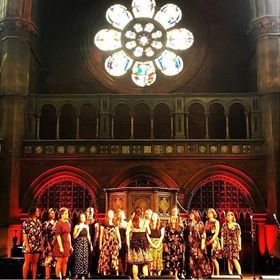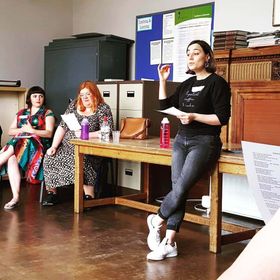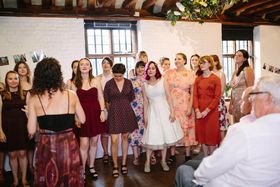Beautiful musical chaos
When I tell people I’m in a choir, some of them imagine the same thing: churches, robes and choral music. Pious singing faces.
(To be clear, I’ve done that kind of choir before and it’s great in its own way, but that’s very much not what goes on in this one.)
Generally, though, people respond with the question, “what kind of choir is it?”. What indeed.
A post by Phil Hawksworth earlier this year about his newfound love of choir really resonated because I knew exactly how it felt to be completely, unexpectedly sucked in to this hobby.

I’d been in various choirs before, classical ones, but only joined SHE Choir because I’d just moved back to London and didn’t know anyone. The choir started life as a student society in Manchester where I studied, and I’d gone to a few sessions the year before, but now the founders had moved back to London and brought the choir with them. It was chaotic, but I was hooked immediately.
A few months in, I decided I wanted to try arranging something. I remember asking if it was okay for me to have a go, and I put together a three-part arrangement of Don’t Panic by Coldplay. I was too nervous to sing in front of people so I got someone else to teach it. But it sounded good.
A weekend away with both the London and Manchester choirs to a druid camp in a remote part of the Midlands – involving sleeping next to a creepy fur-clad mannequin, lots of singing in yurts, and a bunch of city women completely failing to work a log fire – finally gave me the confidence to start singing on my own in front of people. I realised that choir was a safe space for me to do that, to teach and learn at the same time. After I got back, coasting on the high from the weekend, I arranged Fleetwood Mac’s song Everywhere and that would become the first thing I taught by myself.
From there, the choir became something I could actively contribute to. Not long after that the founders left and, not wanting to see this lovely motley crew disappear, a couple of us took over as organisers. That was a lot of work for two people (you can see why people do it as a full-time job!) so we eventually transitioned to a team-based structure. It’s less rigorous and a bit more anarchic, but it means less responsibility falls on one person’s shoulders. (I’m always and forever the admin queen... and of course I built the website.)

We became an a cappella group solely because none of us could play the piano. I got us on Slack because that was what you did in 2014, and we got organised. We started taking attendance, and the revolving door of people coming and going and never learning the songs became a more reliable core membership of regulars who got better every week. I got fed up of taking attendance very quickly, and built a Slack integration that did it for us.
We met up with another more established women’s choir in London and attended each other’s rehearsals to swap tips. They had been the inspiration for our choir’s existence. I was blown away by them, and imagined that maybe one day we’d be as good as them.
Over the years I’ve arranged and taught songs by Alice Cooper, The Postal Service, Imogen Heap, Bruce Springsteen, Chaka Khan, Wheatus, Regina Spektor, Dolly Parton, and more. Ain’t Nobody is well-known enough to most, and my arrangement simple enough, that for a while it became the first song anyone taught when a new branch of the choir popped up. It’s quite a feeling to stand on a stage in front of a hundred or so people from all over, most of whom you’ve never met, and conduct them all singing a song that you arranged.
Conducting isn’t just waving your hands about and being a human metronome. It's conveying emotion, volume, shape of the sound. For me, the most special part of it is having your arrangement sung back at you with the full weight of the choir behind it – it often makes me emotional to hear those little crunchy chords I put in reflected so beautifully in the choir’s strong voices. I did this.
As time goes by the thing I enjoy the most is watching new conductors get that same joy from standing at the front and hearing their arrangement sung back at them. It can be a very vulnerable thing to put yourself at the front, and I’m so glad we’ve given people the opportunity to try new things out, arrange these songs nobody else knows but that mean so much to them, and learn new skills along the way.

Three years after we attended the other choir’s rehearsal, we were on the same billing as them at a festival in London. I watched their set and realised that we were not only that good, but also so different. Going a cappella had actually forced us to be more creative with our arrangements, being the bass and the instruments as well.
The choir that was once just in Manchester and London is now all over England, Germany and New Zealand. People love it so much that when they move away, they start up a new one wherever they end up. For a while there was one in a remote skiing town somewhere in France. Our London group is changing our name now, to better reflect the diversity of our members: we've called ourselves Mixtape. The perfect name for a weird and wonderful collection of songs, and people.
On Thursday night at our winter gig I stood in front of the choir and waved my arms around to the tune of Dancing In The Dark by Bruce Springsteen, one of the most ambitious arrangements I’ve done – and the choir nailed every note. We’re an amateur choir in every way: no auditions, collectively and chaotically self-organised, and we’re all just making it up as we go along. But we’re so good at it.
I’ve invested a third of my life in this choir and there have been moments when I’ve been overcome with frustration (nobody’s doing anything! I have to do everything!) or worry (why hasn’t anyone learned the song?). But reflecting on how far we’ve come and what we’ve brought to people’s lives makes it all worth it.
Those are the moments I live for: the biggest smile on a new conductor’s face as they conduct their song in public for the first time; the “I’m not sure if this is going to sound good” but it always does; the “okay, sure, I’ll have a go” from a quiet person; the drunken renditions of every song we’ve ever done, fuelled by too much wine, at every single choir retreat (and yes, it really is exactly like Pitch Perfect); and the teary reflections the morning of the last day of retreat as everyone shares what this choir means to them. And ultimately, it’s been a lifeline for me during some of the hardest times of my life.
Of course, I could never convey all of that in one sentence when asked “what kind of choir is it?”. So I just say “it’s a pop choir.” But it’s a lot more than that, really, isn’t it?
